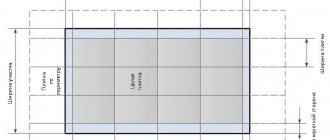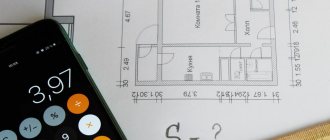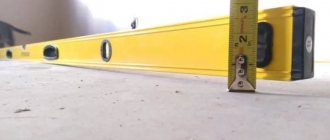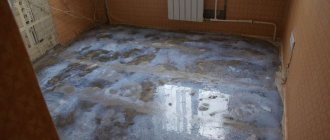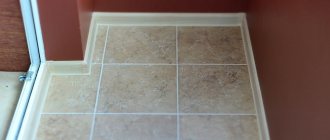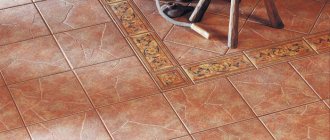Depending on the specific type, the cost of ceramic tiles can reach high values. Its rational use is one of the options for reducing the cost of finishing work. Correct calculations of needs are an effective way to save money. How to accurately calculate bathroom tiles and reduce waste? The work should be done in several stages.
Determining the required amount of ceramic tiles
Calculation methods
Using a calculator will make the calculations much faster, but the results may be somewhat inaccurate. Therefore, when buying expensive luxury tiles, it is better to independently check the result obtained on the calculator.
Before starting the calculation, you need to determine:
- layout type;
- tile colors and their quantity;
- the need to use decorative elements;
- the presence of a pattern to which the material will need to be adjusted;
- tile size.
Length, width and thickness of tiles
According to overall dimensions, facing tiles are divided into:
- classic – with a side of 100-500 mm;
- small-sized - this group includes small chips (50x50 mm) used to create mosaic compositions;
- large-sized - with a side from 500 to 1200 mm.
Wall decoration, in most cases, is made with rectangular tiles with dimensions of 200x250 or 200x300 mm. But products with sides of 120x240, 150x200 and 150x150 mm are also often used.
Layout type
There are three layout options:
- Classical.
The room is divided horizontally into two parts. They are separated by a border and differ in color. The lower part is usually made dark, and the upper part lighter.
Classic layout Source profiplitka.ru
- Plain.
Tiles of the same color are used. As a rule, the presence of decor is assumed.
Plain layout Source eto-vannaya.club
- Combined.
For the layout, tiles of several colors are selected, most often three.
Combined layout Source otdelkino.ru
Glue consumption depending on the type of tile
As we noted earlier, tile materials vary in size, purpose and composition. The calculation of glue also depends on this. So, the larger the size of the facing element, the thinner the adhesive layer will be, therefore, the more kilograms of glue will be needed.
If you are using small mosaics or tiles (10x10 cm), then the layer of adhesive does not exceed 1-2 mm. For tiles and decorative inserts of medium size (20x30 cm), you will need a layer of adhesive 3 mm high. For large tiles (30x30 cm or more), the height of the adhesive pad should reach 5 mm.
If you are using tiles with a surface width of more than 60 cm, an additional adhesive layer must be applied to the back side of the tile.
When choosing a facing material, in addition to the front side, always pay attention to the back of the tile. The fact is that it can be ribbed, and the glue consumption also depends on the degree of unevenness of the surface: in some cases it is recommended to apply it to the back surface of the element being laid.
Method of calculation using a calculator
To calculate tiles for a room using a calculator, you must enter the following data:
- room parameters;
- the area of the door, which should be subtracted from the total area;
- dimensions of the bathtub, the need to line the ends and floor under the bathtub;
- dimensions of one element;
- the required reserve is best if it is 5-10 percent.
See also: Catalog of companies that specialize in finishing materials and related work
How to calculate glue consumption depending on brand
As mentioned above, types of tiles of different characteristics, material and quality composition are used for premises for different purposes: for the street, home and industrial premises; floor and wall; large and small; tiles, ceramics, stone, PVC; for the bathroom, kitchen, swimming pool, hallway, etc. Let's consider the most popular brands of adhesive mixtures and their consumption rates.
Depending on the manufacturer, the glue can be different: epoxy, dispersion and cement.
- Epoxy adhesive on sale comes in two components: resin and catalyst, which must be mixed before starting work. When using this type, experienced finishers should be invited to do the facing work. The advantages of this type of glue are strength and water resistance, as well as resistance to temperature changes and lack of shrinkage even under significant loads. The most famous brands are Litokol and Lugato. The consumption of these brands is 1.5 kg per 1 m2.
- Dispersion adhesive is a ready-made composition that does not require preparatory mixing procedures. The advantages of this resin-based adhesive are its affordable price, ease of installation, viscosity, and strength. However, there is also a significant disadvantage - poor waterproofing properties.
- Cement glue is a dry mixture that is pre-mixed with water before starting work. This is the most inexpensive option, however, an inexperienced master in this case risks making a mistake with the proportions, and then the resulting mixture may lose its fixing properties. The advantage of this type, in addition to the attractive price, is also the ease of dismantling. Among the representatives of this type of glue are the brands “Unis”, “Ceresit”, “Hercules” and “EK”. The consumption of these brands of glue is more than 2 kg per 1 square meter with a layer thickness of 1 mm. In particular, “Unit Granite” and “Unis Plus” have a consumption of 3.5 kg of adhesive per 1 square when using a No. 6 spatula. One square meter of EK brand glue surface will require only 2.5 kg when working with a comb of the same size.
Calculating tiles without a calculator
The amount of ceramics must be calculated manually in the following order:
- Measure the parameters of the walls. If you are going to cover the bathroom screen, you need to find out its dimensions.
- Calculate the area of laying ceramics.
- Subtract from it the dimensions of the door, window, bathtub.
- Calculate the area of one tile.
- Divide the coverage area by the area of one element.
- Take into account the presence of borders and decor. Subtract them.
- If tiles of different colors are used for cladding, it is better to calculate the required material according to the sketch.
Add a margin of 5 - 10 percent. It will be needed if any part of the tile turns out to be defective or damaged during the installation process.
The tiles under the bathroom are not visible Source livemaster.ru
Advice! The part of the floor located under the bathroom can be ignored when calculating the required amount of material. The lack of coating will not be noticeable, but you can save money when buying ceramics.
Grout consumption for tile joints per 1m2 - cost standards
The technology of laying tiles involves the operation of grouting joints - gaps between adjacent pieces.
When performing this, a special composition is used - grout or fugue.
And although the gaps occupy a small part of the covering area, a lot of building material is required. The consumption of grout for tile joints per 1 m2 must be calculated in advance, since it is advisable to purchase its entire volume in one batch.
By room area
This method seems to be the simplest because it is the most understandable. It is most suitable for tiling with single-color tiles of the same size.
Important! If the walls are uneven, tiles should not be laid along them. The floor covering is carried out along a specially laid horizontal line. Then the main part of the ceramics is laid, and only after that the remaining areas and near the walls are filled with small pieces of tiles.
How to calculate the number of tiles per floor based on the area of the room:
- You need to calculate the area of the room: multiply the length by the width. Measurements are taken with a long tape along the walls.
- Add approximately 5-10 percent to the area of the room so that there is a supply of tiles in case of defects or cracks.
- Divide the resulting value by the area of one tile.
- This will give you the number of elements needed to renovate the room.
Important! When receiving a fractional value, it must be rounded up. Otherwise, there may simply not be enough tiles.
Direct method of laying tiles on the floor Source stroimmaster.ru
Calculation of grout consumption: formula
You can calculate the required amount of fugue (Рз) using the formula:
- M – seam length (m/m2)
- K – grout consumption coefficient in g.
The length of the seam M per 1 m2 of tile covering is calculated using the formula:
M = (A + B)/A x B) , where
A and B – length and width of the tile, in m
Coefficient K = W x D x P , where
- W and D – width and depth of the seam in mm
- P – density or volumetric weight of the fugue.
By number of rows
There is another method for calculating the required material for laying ceramics on the floor. It is based on determining the number of rows of tiles. To do this you need:
- Measure the parameters of the room.
- Find out the dimensions of one tile.
- Divide the length of the room by the length of one element. The resulting number is the number of rows.
- Divide the width of the room by the width of one tile.
- If necessary, round values up.
- Add about 10% to them for reserve.
Calculation example for a small bathroom
Let's say there is a bathroom with an area of 2.56 sq.m and has the following parameters:
- height – 2600 mm;
- short side length – 1500 mm;
- the length of the side along which the bathtub will stand is 1710 mm.
Plus, there is a doorway - 750*2000 mm.
The tile chosen for the floor is square, measuring 330*330 mm, and for the walls - 200*300 mm with a vertical arrangement.
Square tiles make the interior more symmetrical, vertically elongated tiles visually raise the ceiling, and horizontally elongated tiles expand the room.
As a result, for calculations we get a bathroom with the following data (mm):
- room height (H) – 2600;
- opening height (Hp) – 2000;
- room depth (A) – 1500;
- room width (B) – 1710;
- opening width (Bp) – 750;
- bath length (C) – 1500;
- bathtub width (D) – 700.
The easiest way is to calculate the tiles for the floor. First, divide B by the width of the floor tiles 1710/30 = 5.18. Rounding up we get 6 pieces in a row. Then we divide A by the length of the same floor tile 1500/330 = 4.56. Rounding, we get 5 rows. Total: 6*5 = 30 tiles per floor.
In this case, on one side of the row we get a trim of approximately 60 mm (330 * 0.18). If the tiles are cut accurately without breaking, then instead of 30 you can take only 28 pieces.
For wall surfaces, the calculations are as follows. For a wall with a door, the top two rows have 9 tiles each (1710/200 = 8.55), and another 7 rows have 5 each (2000/200 = 5). The total is 18+25 = 43.
The number of rows is calculated as follows:
- for the top two - above the door there is a clearance of 600 mm with a tile height of 300 mm;
- and the opening itself – 2000/300 = 6.67.
For the wall opposite the door – 1710/200 = 8.55 and 2600/300 = 8.67, we get 9*9 = 81 tiles. From this number you need to subtract 21 pieces for the tiles located behind the bathroom. There is no need for cladding.
For two narrow walls - 1500/200 = 7.5 and 2600/300 = 8.67, we get 8 * 9 * 2 = 144. It will be difficult to come up with anything with scraps here.
The total is: 144+60+43 = 247 pieces for the walls and 28 pieces for the floor. Plus, just in case, it doesn’t hurt to add a spare 10% to these numbers and you can go to the store for tiles.
Piece method
This method is usually used if expensive tiles are purchased for installation or a pattern is created. This is due to the fact that when counting material individually, the error is minimal.
The process of laying floor tiles Source goodwood.spb.ru
Important! For laying tiles diagonally, this method of calculating tiles is not suitable.
The process is painstaking, but at the same time simple.
How to count tiles this way:
- We need to find out the dimensions of the room.
- Measure the parameters of one installation element.
- Count the number of rows and elements in each row.
- Multiply the resulting numbers. The value will be the number of elements needed to cover.
- Then draw a diagram of the floor covering and determine how many tiles of a certain color will be needed.
- Subtract the number of elements of a non-primary color from the total number.
- You will get several meanings. According to them, you will need to buy a certain number for each type of coverage.
Rules for calculating tiles for all surfaces
How to calculate tiles for a bathroom? You just need to follow the recommendations of experts:
- The basis for a correct calculation is correct measurements. If the bathroom has a square shape, then it is enough to measure only one wall with a tape measure. If the bathroom is rectangular, then measure one short and one long wall. In a situation where the bathroom has a complex shape, you will have to measure every surface, incl. niches and ledges.
- In some formulas for calculating tiles, you need to know the area of the room. This value should be calculated in advance. How to calculate how many square meters are in a bathroom? To do this, you need to multiply the length of the room by the height of the ceilings.
- If you plan to lay out complex material, it is recommended to first draw a sketch on paper. This way you can clearly see the future result of the repair, calculate the exact amount of tiles and mark the location of the furniture.
- Don't try to calculate everything down to the millimeter. Repair is an unpredictable process. It is better to purchase materials with a small supply, so that in case of unsuccessful trimming or accidental breakage you do not have to go to the store.
The calculation of tiles should be taken with full responsibility
Seam width
Seams can be from 1 to 10 millimeters wide. It depends on the type, geometry and size of the tile used. As a rule, the seam width is 2 millimeters.
Grouting process Source otlichnyjremont.ru
When performing the correct layout, the width and length of the seams can be ignored.
For example, there is a wall 1.5 meters long and a tile 0.4 meters long. Algorithm of actions:
- Measure the length of the wall - 1.5 meters.
- Calculate how many meters you can cover with whole uncut tiles: 0.4 * 3 = 1.2 meters.
- Subtract one tile: 1.2 – 0.4 = 0.8.
- Subtract this size from the length of the wall: 1.5 – 0.8 = 0.7 meters.
- Divide into two parts because the tiles will be cut twice equally at the edges: 0.7 / 2 = 0.35 meters.
- Laying should begin from the center.
- Lay two 0.8 meter tiles and two cut tiles at the edge - 0.35 meters. The result will be 1.5 m. Even if the seams reach one centimeter, this will not change anything. The trimmings will probably become a little smaller.
What parameters should you pay attention to?
The consumption of the fugue is influenced by several factors:
- Density: depends on the formulation of the composition and its manufacturing technology. Manufacturers indicate this characteristic on the packaging container.
- The overall dimensions of the tile: its length, width and thickness determine the parameters of the seam.
- Seam width: recommendations for tiling work indicate the minimum allowable gaps between tiles. But designers often make them wider - up to 2-3 cm. The grout manufacturer must indicate in the instructions what width of joints this product is intended for.
- Seam depth: this parameter depends on the total thickness of the tile and the adhesive layer.
The grout not only holds it together, but also decorates the cladding. Depending on the chosen color and structure of the fugue, you can emphasize the contours of the styling pattern or make the seams invisible.
Briefly about the main thing
Before purchasing ceramic tiles, you need to calculate the required amount of material so that it is enough for the entire area of the room. This can be done in two ways: manually and using an online calculator.
The amount of ceramics required for renovation is influenced by the area of the room, the dimensions of the doors, windows and bathroom, the type of installation, the number of colors of the finishing material and other factors.
To calculate floor tiles, 5 methods are used: methods based on the area of the room and the number of rows, counting when laying diagonally and the piece method, combined calculation.
If you do not want to carry out the calculations yourself, when purchasing material, you can contact the store manager. It will help you calculate the required amount of materials for the room. To do this, you will need to first take measurements of the room.
Ratings 0
What to consider when making calculations
When calculating tiles, you should consider:
- Bathroom dimensions;
- Laying method;
- Tile sizes;
- Color scheme.
Horizontal laying of rectangular tiles helps to visually expand the space of the room
Methods for laying tiles
There are several ways to lay tiles:
- Straight. This is the easiest way, suitable for beginners.
- Diagonal. Allows you to visually expand the space and hide the curvature of the floors. This method takes longer than the direct one. When laying diagonally, a lot of material is consumed, so the supply of tiles should be 15-20% more than the required amount.
- Chess. It is used when finishing tiles of different colors, for example: black and white, milky and brown, white and green, yellow and blue.
- With offset. Each subsequent row of tiles is shifted the same distance. This styling looks interesting, elegant, and unusual. You can experiment and add a variety of inserts.
The method of laying tiles in a bandage resembles brickwork and is suitable for rectangular tiles
The advantages of a plain finish
Laying plain tiles is much easier than tiles with a pattern or pattern. The advantages of installing simple plain tiles include:
- Possibility to start installation from any corner of the bathroom. This material does not need to be adjusted to the pattern or positioned to create a symmetrical pattern.
- Trimming from any side. If there is a pattern on the tile, then cutting in the wrong place can ruin the whole picture. There are no such problems with a single-color coating.
- Using the remaining pieces of material for lining corners or niches without adjusting to the pattern.
Plain tiles in a bathroom in the Casual Loft style look very stylish
Choosing a finish with a pattern and design will highlight the bathroom interior and add some zest to it. A plain surface looks simpler, but it saves effort, time and money spent on repairs. An alternative to a pattern on the entire wall can be decorative inserts - individual patterned tiles that can be organically placed between plain elements.
Attention! If the owners plan to decorate the interior with decorative inserts, then their number must be subtracted from the number of the main tiles.
When making calculations, the area of borders and decorative elements should be taken into account separately.
Consequences of incorrect tile calculations
Incorrect calculation of bathroom tiles can lead to:
- Excess. The excess tiles have nowhere to be used and cannot be returned. This option will lead to unnecessary expenses.
- Deficiency. This often happens to people who want to save money. As a result, there are not enough tiles, and you have to go to a hardware store to get them, where all the material may already be sold out. In such a situation, you will either have to completely redo the walls or floor using new tiles, or complete the cladding using a material of a similar color. The last design option can ruin the entire design.
Particular care should be taken when calculating tiles with a pattern.
Attention! Today on the Internet you can find many online calculators that help you calculate the amount of tiles for finishing. They all have a significant drawback: they work without taking into account ledges, niches, doors and windows.
Let's look at the main types of solutions
- cement;
- dispersive;
- composition using epoxy resin.
The advantages of the dispersion composition are low consumption per square meter. m. (square meter), elasticity and strength. In addition, such a solution is sold in ready-made form, which is very convenient for work. Among the disadvantages, one can note its low waterproofing properties.
We use the simplest way to calculate the need for tile adhesive
- "Unis" (Yunis) - 1.2 kg/m2;
- "Ceresit" (Ceresit) - 1.6 kg/m2;
- "Hercules" - 1.5 kg/m2;
- “Knauf” (Knauf) - 1.1 kg/m2;
- "Litokol" (Litokol) - 1.5 kg/m2;
- "EK" - 1.1 kg/m2.
However, not everything is as simple as it might seem at first glance. The consumption of adhesive composition for laying 1 m2 of ceramic cladding is influenced by many factors: the quality of the base, the type of glue, the size of the tile, etc. Let's consider all these factors.
The size and type of veneering ceramics matter
Also, when calculating, it is necessary to take into account the type of tile. Due to its high porosity, handmade tiles absorb glue better than standard tiles. In addition, designer types of tiles often have a very uneven back surface, which also increases glue consumption.
To prevent the influence of these factors on glue consumption from being critical, it is recommended to use special adhesive compositions. For example, the composition “EK-6000 MOZAIK” is used for laying mosaics, and the adhesive “EK-8000 KAMIN” is used for heat-resistant tiles. And for tiling and porcelain tiles, the universal product is “EK-3000”, which is strong and durable.
